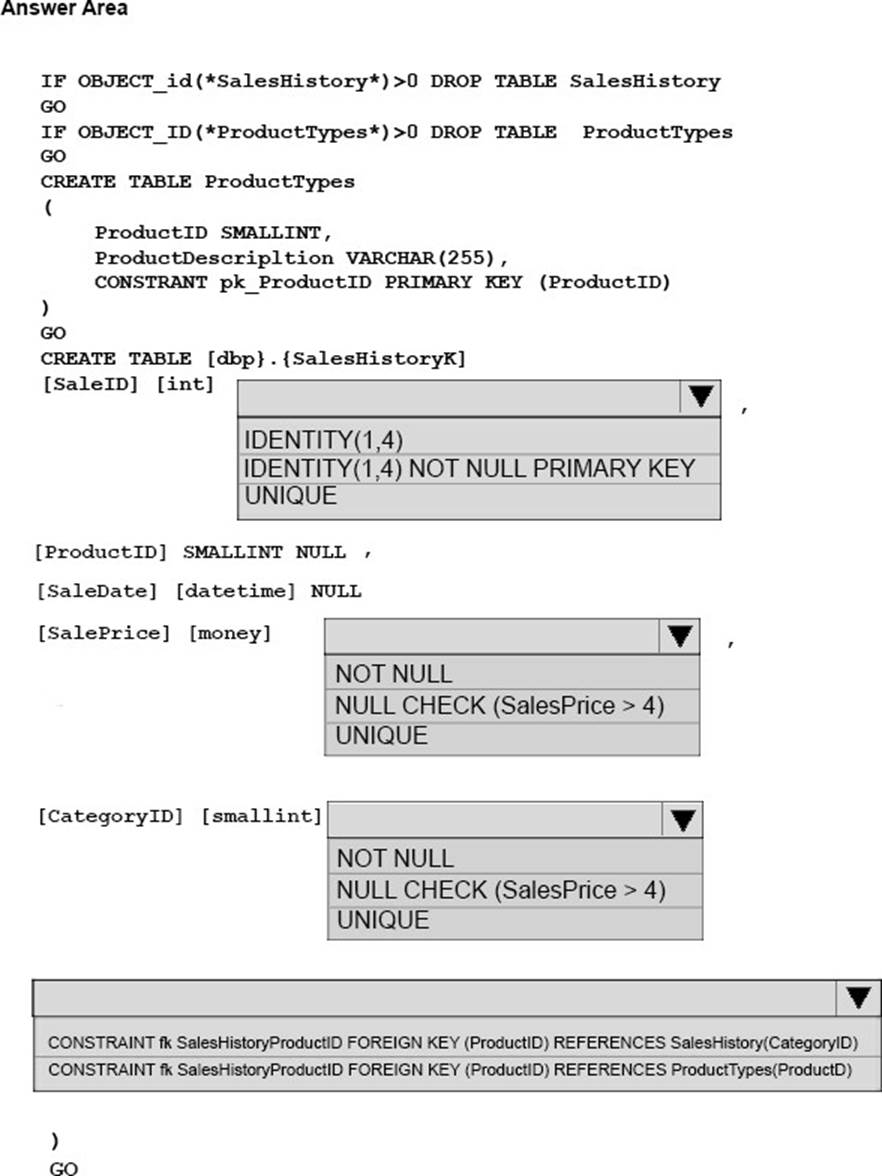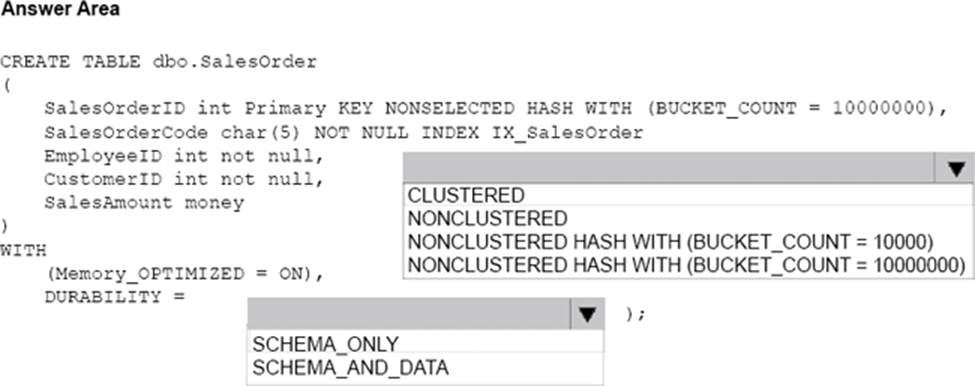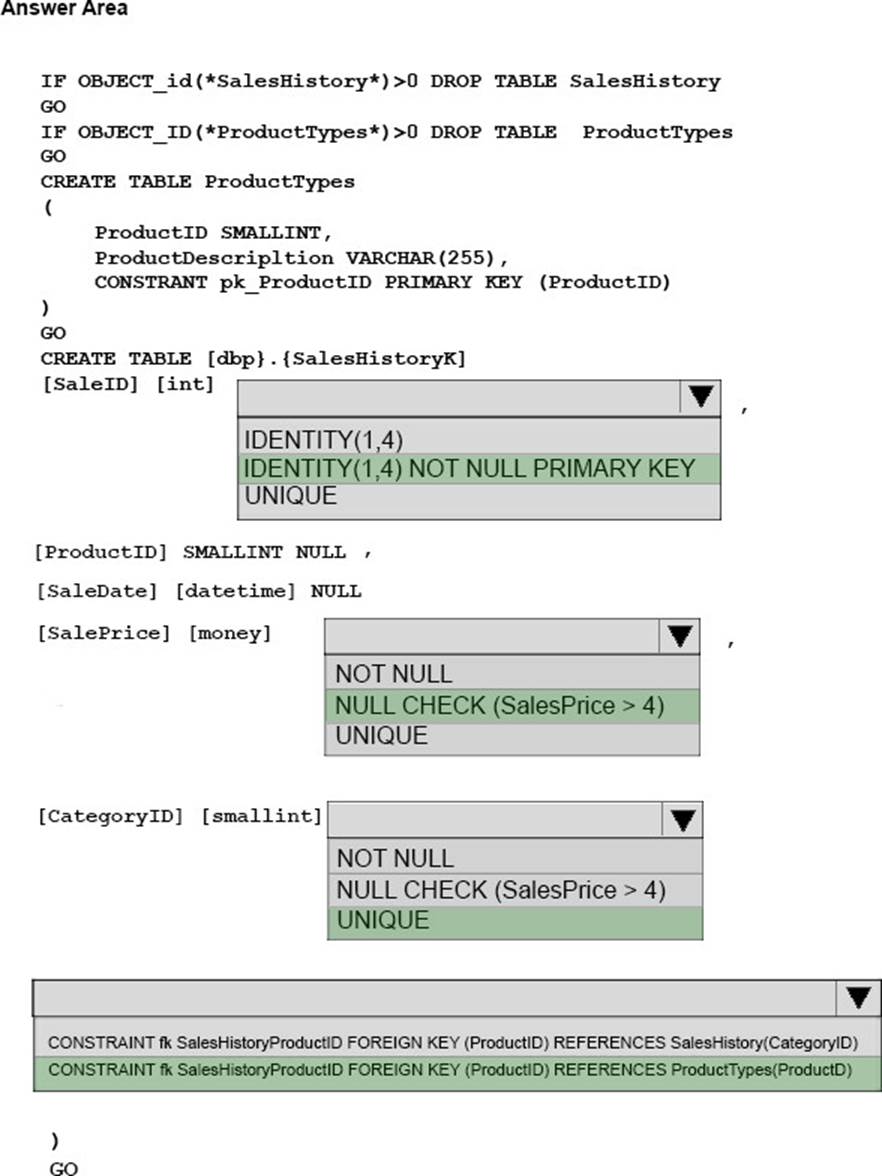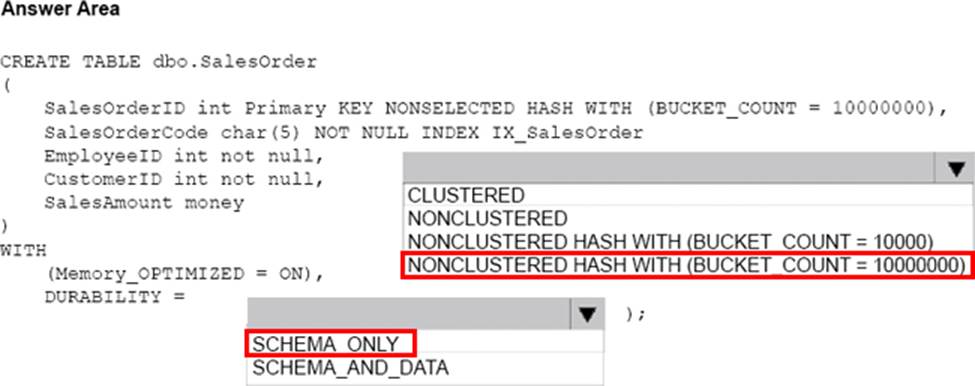Microsoft 70-762 Developing SQL Databases Online Training
Microsoft 70-762 Online Training
The questions for 70-762 were last updated at Jan 21,2025.
- Exam Code: 70-762
- Exam Name: Developing SQL Databases
- Certification Provider: Microsoft
- Latest update: Jan 21,2025
Notify the sales person who places an order whether or not the order was completed.
You must add the following constraints to the SalesHistory table:
– a constraint on the SaleID column that allows the field to be used as a record identifier
– a constant that uses the ProductID column to reference the Product column of the ProductTypes table
– a constraint on the CategoryID column that allows one row with a null value in the column
– a constraint that limits the SalePrice column to values greater than four
Finance department users must be able to retrieve data from the SalesHistory table for sales persons where the value of the SalesYTD column is above a certain threshold.
You plan to create a memory-optimized table named SalesOrder.
The table must meet the following requirments:
– The table must hold 10 million unique sales orders.
– The table must use checkpoints to minimize I/O operations and must not use transaction logging.
– Data loss is acceptable.
Performance for queries against the SalesOrder table that use Where clauses with exact equality operations must be optimized.
You need to update the SalesHistory table
How should you complete the Transact_SQL statement? To answer? select the appropriate Transact-SQL, segments in the answer area.

Notify the sales person who places an order whether or not the order was completed.
You must add the following constraints to the SalesHistory table:
– a constraint on the SaleID column that allows the field to be used as a record identifier
– a constant that uses the ProductID column to reference the Product column of the ProductTypes table
– a constraint on the CategoryID column that allows one row with a null value in the column
– a constraint that limits the SalePrice column to values greater than four
Finance department users must be able to retrieve data from the SalesHistory table for sales persons where the value of the SalesYTD column is above a certain threshold.
You plan to create a memory-optimized table named SalesOrder.
The table must meet the following requirments:
– The table must hold 10 million unique sales orders.
– The table must use checkpoints to minimize I/O operations and must not use transaction logging.
– Data loss is acceptable.
Performance for queries against the SalesOrder table that use Where clauses with exact equality operations must be optimized.
You need to update the SalesHistory table
How should you complete the Transact_SQL statement? To answer? select the appropriate Transact-SQL, segments in the answer area.

Notify the sales person who places an order whether or not the order was completed.
You must add the following constraints to the SalesHistory table:
– a constraint on the SaleID column that allows the field to be used as a record identifier
– a constant that uses the ProductID column to reference the Product column of the ProductTypes table
– a constraint on the CategoryID column that allows one row with a null value in the column
– a constraint that limits the SalePrice column to values greater than four
Finance department users must be able to retrieve data from the SalesHistory table for sales persons where the value of the SalesYTD column is above a certain threshold.
You plan to create a memory-optimized table named SalesOrder.
The table must meet the following requirments:
– The table must hold 10 million unique sales orders.
– The table must use checkpoints to minimize I/O operations and must not use transaction logging.
– Data loss is acceptable.
Performance for queries against the SalesOrder table that use Where clauses with exact equality operations must be optimized.
You need to update the SalesHistory table
How should you complete the Transact_SQL statement? To answer? select the appropriate Transact-SQL, segments in the answer area.

Notify the sales person who places an order whether or not the order was completed.
You must add the following constraints to the SalesHistory table:
– a constraint on the SaleID column that allows the field to be used as a record identifier
– a constant that uses the ProductID column to reference the Product column of the ProductTypes table
– a constraint on the CategoryID column that allows one row with a null value in the column
– a constraint that limits the SalePrice column to values greater than four
Finance department users must be able to retrieve data from the SalesHistory table for sales persons where the value of the SalesYTD column is above a certain threshold.
You plan to create a memory-optimized table named SalesOrder.
The table must meet the following requirments:
– The table must hold 10 million unique sales orders.
– The table must use checkpoints to minimize I/O operations and must not use transaction logging.
– Data loss is acceptable.
Performance for queries against the SalesOrder table that use Where clauses with exact equality operations must be optimized.
You need to update the SalesHistory table
How should you complete the Transact_SQL statement? To answer? select the appropriate Transact-SQL, segments in the answer area.

Notify the sales person who places an order whether or not the order was completed.
You must add the following constraints to the SalesHistory table:
– a constraint on the SaleID column that allows the field to be used as a record identifier
– a constant that uses the ProductID column to reference the Product column of the ProductTypes table
– a constraint on the CategoryID column that allows one row with a null value in the column
– a constraint that limits the SalePrice column to values greater than four
Finance department users must be able to retrieve data from the SalesHistory table for sales persons where the value of the SalesYTD column is above a certain threshold.
You plan to create a memory-optimized table named SalesOrder.
The table must meet the following requirments:
– The table must hold 10 million unique sales orders.
– The table must use checkpoints to minimize I/O operations and must not use transaction logging.
– Data loss is acceptable.
Performance for queries against the SalesOrder table that use Where clauses with exact equality operations must be optimized.
You need to update the SalesHistory table
How should you complete the Transact_SQL statement? To answer? select the appropriate Transact-SQL, segments in the answer area.

If an error occurs during a delete operation on either table, all changes must be rolled back, otherwise all changes should be committed.
How should you complete the procedure? To answer, select the appropriate Transact-SQL segments in the answer area.

If an error occurs during a delete operation on either table, all changes must be rolled back, otherwise all changes should be committed.
How should you complete the procedure? To answer, select the appropriate Transact-SQL segments in the answer area.

If an error occurs during a delete operation on either table, all changes must be rolled back, otherwise all changes should be committed.
How should you complete the procedure? To answer, select the appropriate Transact-SQL segments in the answer area.

If an error occurs during a delete operation on either table, all changes must be rolled back, otherwise all changes should be committed.
How should you complete the procedure? To answer, select the appropriate Transact-SQL segments in the answer area.

If an error occurs during a delete operation on either table, all changes must be rolled back, otherwise all changes should be committed.
How should you complete the procedure? To answer, select the appropriate Transact-SQL segments in the answer area.

Latest 70-762 Dumps Valid Version with 157 Q&As
Latest And Valid Q&A | Instant Download | Once Fail, Full Refund



